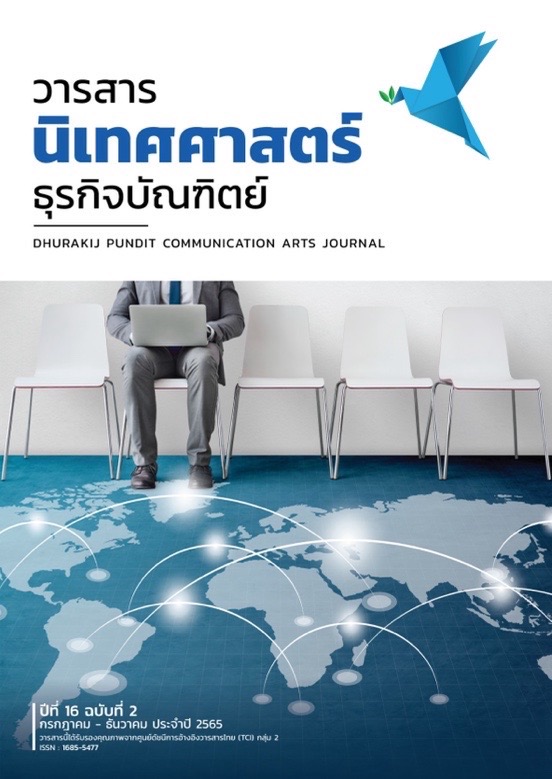การสื่อสารเพื่อสร้างประสบการณ์ของแชทบอท ในธุรกิจซื้อขายสินค้า ที่ส่งผลต่อความภักดีของลูกค้า
คำสำคัญ:
แชทบอท, ธุรกิจซื้อขายสินค้า, แชท คอมเมิร์ซ, การสื่อสารเพื่อสร้างประสบการณ์, ความภักดี, การบอกต่อ, ความตั้งใจซื้อซ้ำ, การเป็นทางเลือกแรกในใจ, ประสบการณ์ลูกค้าบทคัดย่อ
การวิจัยครั้งนี้ มีวัตถุประสงค์ 2 ข้อ คือ 1) เพื่อศึกษากระบวนการสื่อสารเพื่อการสร้างประสบการณ์ ของแชทบอท ในธุรกิจซื้อขายสินค้า 2) เพื่อศึกษาความสัมพันธ์และอิทธิพล ระหว่างทัศนคติที่มีต่อการสื่อสารเพื่อสร้างประสบการณ์ของ แชทบอท ในธุรกิจซื้อขายสินค้า กับการสร้างความภักดีของลูกค้า ใช้การวิจัยแบบผสมด้วยการวิจัยเชิงคุณภาพ (Qualitative Research) โดยการสัมภาษณ์แบบเจาะลึก (In-depth Interviews) นักวิชาชีพการตลาด นักพัฒนาเทคโนโลยี และนักวิชาการจำนวน 6 คน และการวิจัยเชิงปริมาณ (Quantitative Research) กับกลุ่มตัวอย่างที่เคยมีประสบการณ์การซื้อสินค้าผ่าน “แชทบอท” 2 ครั้งขึ้นไป จำนวน 360 คน
ผลการศึกษาพบว่า ผู้ประกอบการธุรกิจได้นำ “แชทบอท” มาใช้เป็นเครื่องมือสื่อสารการตลาดดิจิทัลในการบริหารจัดการประสบการณ์ของลูกค้าตลอดเส้นทางการบริโภคของลูกค้า (Customer Journey) ประกอบด้วย ช่วงก่อนการซื้อ (Pre-Purchase) เพื่อเก็บข้อมูลและนำไปวิเคราะห์ความสนใจของลูกค้า ช่วงระหว่างซื้อ (Purchase) เพื่อตอบคำถาม และ ให้บริการขายสินค้า ช่วงหลังการซื้อ (Post-Purchase) เพื่อส่งโฆษณาแบบรายบุคคล กระตุ้นจูงใจให้เกิดการซื้อซ้ำ โดยมุ่งออกแบบเนื้อหาสาร ร่วมกับการนำเทคโนโลยีปัญญาประดิษฐ์ (Artificial intelligence: AI) ที่ช่วยเรื่องจดจำข้อมูลลูกค้าได้จำนวนมาก ทั้งด้านความชอบ ประวัติการซื้อ ประวัติการสอบถามข้อมูลนำมาใช้ร่วมกับ “แชทบอท” ในการสื่อสารเฉพาะบุคคล (Personalized) ผ่านคุณลักษณะ 2 ประการ คือ 1) การสร้างประสบการณ์ทางด้านกายภาพ ประกอบด้วย ด้านผลิตภัณฑ์และบริการ , ด้านราคา , ด้านระบบโต้ตอบและแอดมิน ด้านระยะเวลา , ด้านเนื้อหาการตลาด และประสบการณ์ทางความรู้สึก และ 2) การสร้างประสบการณ์ทางอารมณ์ ความรู้สึก ประกอบด้วย ด้านบุคลิกภาพ, ด้านการให้ข้อมูลที่ตอบสนองอารมณ์ความรู้สึก ด้านการสร้างการมีส่วนร่วม , ด้านการให้ความเป็นผู้ช่วยเสมือนของมนุษย์ และด้านความเชื่อมั่นไว้วางใจจนเกิดการตัดสินใจซื้อ ตอกย้ำให้เกิดความพึงพอใจจนเกิดทัศนคติเชิงบวก และพัฒนาไปสู่ความภักดีของลูกค้าที่มีต่อแบรนด์ ผ่านการบอกต่อ (Word of Mouth) ความตั้งใจซื้อซ้ำ (Repurchase Intention) และการเป็นทางเลือกแรกในใจ (First-in-Mind) ได้
เอกสารอ้างอิง
ธีรพันธ์ โล่ห์ทองคำ. (2550). รูปแบบกลยุทธ์การใช้เครื่องมือสื่อสารการตลาดเชิงบูรณาการ ในการบริหารคุณค่าตราสินค้า ตามระดับความสำคัญของผลิตภัณฑ์ [ปริญญานิพนธ์ปริญญาดุษฎีบัณฑิต, มหาวิทยาลัยรามคำแหง]. สำนักหอสมุดกลาง มหาวิทยาลัยรามคำแหง. https://digital.lib.ru.ac.th/m/b11410541/Teerapunlotongkum.pdf
ปกรณ์ เอี่ยมศิรินพกุล. (2560). การวิเคราะห์เนื้อหาการสื่อสารใน Facebook fanpage ของสถาบันสอนภาษาอังกฤษ Globish English school [การค้นคว้าอิสระปริญญามหาบัณฑิต, มหาวิทยาลัยกรุงเทพ]. มหาวิทยาลัยกรุงเทพ. http://dspace.bu.ac.th/bitstream/123456789/2965/1/pakorn_ieam.pdf
สุวิมล แม้นจริง. (2546). การจัดการการตลาด. เอส. เอ็น .กรุ๊ป.
Aaker, D. A. (1991). Managing brand equity: Capitalizing on the value of a brand name. The Free Press.
Anderson, C. (2006). The long tail: Why the future of business is selling less of more. Hyperion.
Arnould, E., Price, L., & Zinkhan, G. (2004). Consumers (2nd ed.). McGraw-Hill/Irwin.
Assael, H. (1998). Consumer behavior and marketing action (6th ed.). Western College.
Belleghem, S. (2016). How the digital world is shaping the modern consumer. Strategic direction, 32(5), 1-2. https://doi.org/10.1108/SD-02-2016-0026
Berlo, D. K. (1977). Communication as process: Review and commentary. Annals of the International Communication Association, 1(1), 11-27. https://doi.org/10.1080/23808985.1977.11923667
Burke, R. R. (2002). Technology and the customer interface: What consumers want in the physical and virtual store. Journal of the Academy of Marketing Science, 30(4), 411-432. https://doi.org/10.1177/009207002236914
Buttle, F. (2009). Customer relationship management: Concept and technologies. Butterworth-Heinemann.
Chen, Y., & Xie, J. (2008). Online consumer review: Word-of-mouth as a new element of marketing communication mix. Management Science, 54(3), 477-491. https://doi.org/10.1287/mnsc.1070.0810
De Haan, H. (2018). Chatbot personality and customer satisfaction [Master’s thesis, Utrecht University]. Utrecht University. https://bit.ly/3zMa4DT
Facebook. (n.d.). Facebook. https://developers.facebook.com/docs/messenger-platform/reference/send-api/
Fatma, S. (2014). Antecedents and consequences of customer experience management: A literature review and research agenda. International Journal of Business and Commerce, 3(6), 32-49. https://www.researchgate.net/publication/3192564
Jacoby, J., & Chestnut, R. (1978). Brand loyalty measurement and management. Wiley.
Keller, K. L. (1998). Strategic brand management. Prentice-Hall.
Keller, K. L. (2008). Strategic brand management: Building, measuring, and managing brand equity. Pearson/Prentice Hall.
Kotler, P., & Keller, K. L. (2012). Marketing management (12th ed.). Pearson Education.
Kumar, B. V. D. S. S. P., Nithin, A., Devi, S. S., & Rao, P. P. (2021). An empirical study on impact of chatbots in digital marketing communication. International Journal of All Research Education and Scientific Methods (IJARESM), 9(1), 994-1017. http://www.ijaresm.com/uploaded_files/document_file/B.V_.D_.S_Sai_Pavan_Kumar_0EqM.pdf
Kushwaha, A. K., Kumar, P., & Kar, A. K. (2021). What impacts customer experience for B2B enterprises on using AI-enabled chatbots? Insights from Big data analytics. Industrial Marketing Management, 98, 207-221. https://doi.org/10.1016/j.indmarman.2021.08.011
Lovelock, C. H., Patterson, P. G., & Walker, R. H. (1998). Services marketing: Australia and New Zealand. Prentice Hall.
Mathwick, C., Malhotra, N., & Rigdon, E. (2001). Experiential value: Conceptualization, measurement, and application in the catalog and internet shopping Environment. Journal of Retailing, 77(1), 39-56. https://doi.org/10.1016/S0022-4359(00)00045-2
Mclaughlin, M. (1984). Conversation: How talk is organized. Sage.
McMillan, S. (2006). Exploring models of interactivity from multiple research traditions: users, documents and systems. In Leah A. Lievroue, and Sonia Livingstone (Eds.), The handbook of new media. https://doi.org/10.4135/9781446211304.n10
Parasuraman, A., & Zinkhan, G. M. (2002). Marketing to and serving customers through the Internet: An overview and research agenda. Journal of the Academy of Marketing Science, 30(4), 286–295. https://doi.org/10.1177/009207002236906
Peras, D. (2018). Chatbot evaluation metrics. In 36th international scientific conference on economic and social development-building resilient society (pp. 89-97). https://bit.ly/3dhl4Bg
Shaw, C., & Ivens, J. (2002). Building great customer experience. Palgrave Macmillan.
Signh, P. (2018). Role of chatbots in the future of digital marketing. https://digitalmarketingwiki.com/role-of-chatbots-in-digital-marketing/
Xie, R., Liu, Z., Yan, R., Sun, M. (2016). Neural emoji recommendation in dialogue systems. https://arxiv.org/pdf/1612.04609.pdf
Zeithaml, V., Berry, L., & Parasuraman, A. (1996). The behavioral consequences of service quality. Journal of Marketing, 60(2), 31-46. https://doi.org/10.1177/002224299606000203
ดาวน์โหลด
เผยแพร่แล้ว
ฉบับ
ประเภทบทความ
สัญญาอนุญาต
ลิขสิทธิ์ (c) 2022 วารสารนิเทศศาสตร์ธุรกิจบัณฑิตย์

อนุญาตภายใต้เงื่อนไข Creative Commons Attribution-NonCommercial-NoDerivatives 4.0 International License.
ลิขสิทธิ์เป็นของวารสาร....




